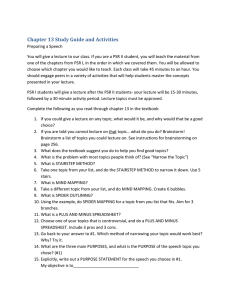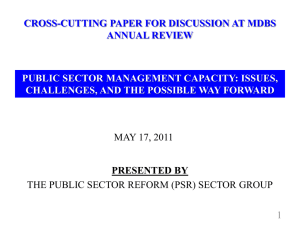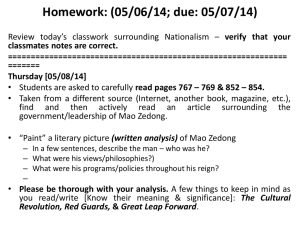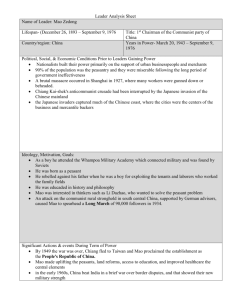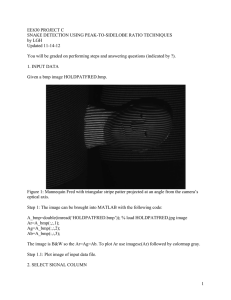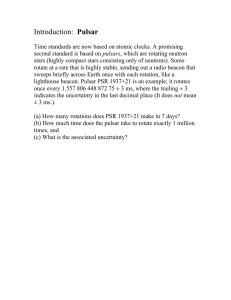State Space Compression with Predictive Representations Abdeslam Boularias Masoumeh Izadi Brahim Chaib-draa
advertisement
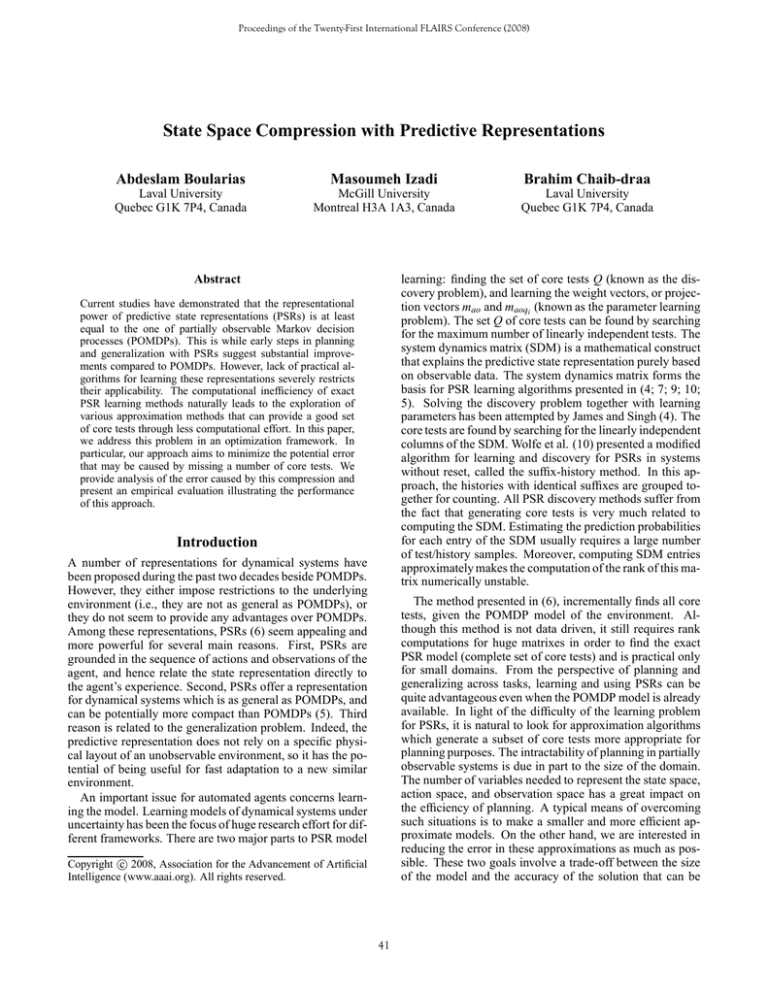
Proceedings of the Twenty-First International FLAIRS Conference (2008)
State Space Compression with Predictive Representations
Abdeslam Boularias
Masoumeh Izadi
Brahim Chaib-draa
Laval University
Quebec G1K 7P4, Canada
McGill University
Montreal H3A 1A3, Canada
Laval University
Quebec G1K 7P4, Canada
learning: finding the set of core tests Q (known as the discovery problem), and learning the weight vectors, or projection vectors mao and maoqi (known as the parameter learning
problem). The set Q of core tests can be found by searching
for the maximum number of linearly independent tests. The
system dynamics matrix (SDM) is a mathematical construct
that explains the predictive state representation purely based
on observable data. The system dynamics matrix forms the
basis for PSR learning algorithms presented in (4; 7; 9; 10;
5). Solving the discovery problem together with learning
parameters has been attempted by James and Singh (4). The
core tests are found by searching for the linearly independent
columns of the SDM. Wolfe et al. (10) presented a modified
algorithm for learning and discovery for PSRs in systems
without reset, called the suffix-history method. In this approach, the histories with identical suffixes are grouped together for counting. All PSR discovery methods suffer from
the fact that generating core tests is very much related to
computing the SDM. Estimating the prediction probabilities
for each entry of the SDM usually requires a large number
of test/history samples. Moreover, computing SDM entries
approximately makes the computation of the rank of this matrix numerically unstable.
Abstract
Current studies have demonstrated that the representational
power of predictive state representations (PSRs) is at least
equal to the one of partially observable Markov decision
processes (POMDPs). This is while early steps in planning
and generalization with PSRs suggest substantial improvements compared to POMDPs. However, lack of practical algorithms for learning these representations severely restricts
their applicability. The computational inefficiency of exact
PSR learning methods naturally leads to the exploration of
various approximation methods that can provide a good set
of core tests through less computational effort. In this paper,
we address this problem in an optimization framework. In
particular, our approach aims to minimize the potential error
that may be caused by missing a number of core tests. We
provide analysis of the error caused by this compression and
present an empirical evaluation illustrating the performance
of this approach.
Introduction
A number of representations for dynamical systems have
been proposed during the past two decades beside POMDPs.
However, they either impose restrictions to the underlying
environment (i.e., they are not as general as POMDPs), or
they do not seem to provide any advantages over POMDPs.
Among these representations, PSRs (6) seem appealing and
more powerful for several main reasons. First, PSRs are
grounded in the sequence of actions and observations of the
agent, and hence relate the state representation directly to
the agent’s experience. Second, PSRs offer a representation
for dynamical systems which is as general as POMDPs, and
can be potentially more compact than POMDPs (5). Third
reason is related to the generalization problem. Indeed, the
predictive representation does not rely on a specific physical layout of an unobservable environment, so it has the potential of being useful for fast adaptation to a new similar
environment.
An important issue for automated agents concerns learning the model. Learning models of dynamical systems under
uncertainty has been the focus of huge research effort for different frameworks. There are two major parts to PSR model
The method presented in (6), incrementally finds all core
tests, given the POMDP model of the environment. Although this method is not data driven, it still requires rank
computations for huge matrixes in order to find the exact
PSR model (complete set of core tests) and is practical only
for small domains. From the perspective of planning and
generalizing across tasks, learning and using PSRs can be
quite advantageous even when the POMDP model is already
available. In light of the difficulty of the learning problem
for PSRs, it is natural to look for approximation algorithms
which generate a subset of core tests more appropriate for
planning purposes. The intractability of planning in partially
observable systems is due in part to the size of the domain.
The number of variables needed to represent the state space,
action space, and observation space has a great impact on
the efficiency of planning. A typical means of overcoming
such situations is to make a smaller and more efficient approximate models. On the other hand, we are interested in
reducing the error in these approximations as much as possible. These two goals involve a trade-off between the size
of the model and the accuracy of the solution that can be
c 2008, Association for the Advancement of Artificial
Copyright Intelligence (www.aaai.org). All rights reserved.
41
obtained. The reduced PSR model, which contains only a
subset of core-tests, conveys this trade-off. In this paper,
we address the issue of dynamically generating approximate
PSR models. We follow the underlying assumption in (6)
to have access to the POMDP model. However, we are interested in a lossy compressed PSR with k number of core
tests (fewer than the number of POMDP states). We formulate this problem as an optimization problem that minimizes the loss function related to prediction of observations
and rewards and show that the approximation errors with respect to the value function solution and belief estimation are
bounded. Our experimental results with this approach are
encouraging. In particular, our method can take advantage
of the POMDP domains which contain structures in the underlying states, transitions, and observations to represent a
very compact model.
that the test succeeds. The conditional probability of a test q
being successful given that the test is performed after history
h is: P(q|h) = P(hq)
P(h) . A set of tests Q is a PSR of a dynamical
system if its prediction, which is called the prediction vector, P(Q|h), forms a sufficient statistic for the system after
any history h, i.e., if a prediction for any test q at any history
h can be computed based on P(Q|h): P(q|h) = fq (P(Q|h)),
where fq : [0, 1]|Q| → [0, 1]. The state update operator can be
f
Background
In this section we briefly describe POMDPs and PSRs.
Formally, a POMDP is defined by the following components: a finite set of hidden states S; a finite set of actions A; a finite set of observations Z; a transition function
T : S × A × S → [0, 1], such that T (s, a, s′ ) is the probability that the agent will end up in state s′ after taking action
a in state s; an observation function O : A × S × Z → [0, 1],
such that O(a, s′ , z) gives the probability that the agent receives observation z after taking action a and getting to state
s′ ; an initial belief state b0 , which is a probability distribution over the set of hidden states S; and a reward function
R : A × S → ℜ, such that R(a, s) is the immediate reward
received when the agent takes action a in hidden state s. Additionally, there can be a discount factor, γ ∈ (0, 1), which is
used to weigh less rewards received farther into the future.
The sufficient statistic in a POMDP is the belief state b,
which is a vector of length |S| specifying a probability distribution over hidden states. The elements of this vector, b(i),
specify the conditional probability of the agent being in state
si , given the initial belief b0 and the history (sequence of actions and observations) experienced so far.
After taking action a and receiving observation z, the
agent updates its belief state using Bayes’ Rule:
b′bao(s′ ) = P(s′ |b, a, o) =
(P(Q|h))
.
written as: P(q|hao) = faoq
ao (P(Q|h))
The size of the model, or the number of extension tests,
is proportional to the size of the set Q. The number of core
tests, |Q|, is called the dimension of the model. The PSR
representation of a dynamical system has at most a number of core test equal to the number of hidden states in the
POMDP representation (6). In fact, the PSR model is potentially more compact than the corresponding POMDP. A
linear-PSR is a PSR in which there exists a projection vector
mq for any test q such that: P(q|h) = P(Q|h)T mq . A linear
PSR model consists of:
• A : finite set of actions;
• O : finite set of observations including rewards;
• Q : finite set of selected tests {q1 , q2 , ..., qk } (core tests);
• mao : weight vectors for projections of one-step tests, defined for each action a ∈ A and each observation o ∈ O;
• maoqi : weight vectors for projections of one-step extensions of core tests, defined for each action a ∈ A, each
observation o ∈ Z and each core test qi ∈ Q.
The matrix containing the predictions of all core tests given
the underlying states is called the U-matrix (|S| × |Q|). The
exact U can be found by searching for the maximum number of linearly independent tests through rank computation
given the POMDP model of the environment (6). Predictive states in PSRs are mapped to belief states in POMDPs
through the definition of U:
P(Q|h) = bT U
(3)
Reward in PSRs is considered as part of the observation. In
this paper, we assume that exists a finite set of real value
rewards, θ . The observable feedback, o = rz, contains the
discrete reward value r ∈ θ and the observation z ∈ Z, as
defined in POMDPs. We can associate a scalar reward for
each action a at each prediction vectorP(Q|h):
O(a, s′ , o) ∑s∈S b(s)T (s, a, s′ )
(1)
P(o|a, b)
where denominator is a normalizing constant and is given
by the sum of the numerator over all values of s′ ∈ S. The
real value reward for taking action a at a belief state b is
computed by:
R(b, a) = bT Ra
(2)
Predictive state representations, as an alternative to
POMDPs, are based on testable experiences. The notion
of test, used in the definition of PSRs, carries the central
idea of relating states of the model to verifiable and observable quantities. A test is an ordered sequence of actionobservation pairs q = a1 o1 ...ak ok . The prediction for a test
q, is the probability of the sequence of observations o1 , ..., ok
being generated, given that the sequence of actions a1 , ..., ak
was taken. If this observation sequence is generated, we say
R(P(Q|h), a) = ∑ rp(r|P(Q|h), a) = ∑ ∑ rP(Q|h)T mao
r
r o∈Z
(4)
To simplify the notations, we let mar = r ∑o∈Z mao . Therefore, the above equation is:
R(P(Q|h), a) = ∑ P(Q|h)T mar
(5)
r
Linear PSRs as lossless representations for
compressed POMDPs
Linear PSRs are able to find special type of structure called
linear dependency (1) in dynamical systems and discover the
42
minimize:
reduced model for given input POMDPs. This structure is in
fact a property of the underlying states of the MDP model.
A linearly dependent state in an MDP is defined to be the
one whose transitions are expressible by a linear combination of the ones from other states. Linear state dependency
is a sufficient condition for the linear PSR to have smaller
dimensionality without losing any information. Considering
the reward as a part of observation, the compression provided by PSRs will preserve the dynamics together with the
values (1).
While lossless compressions preserve the dynamics of
a system in the reduced model, there are other types of
compressions which are more relaxed and only preserve
properties useful for decision making. The value-directed
compression (VDC) algorithm (8) is an example of this
type. VDC computes a low dimensional representation of
a POMDP directly from the model parameters: R, T, and
O by finding a Krylov subspace for the reward function under propagating beliefs. The Krylov subspace for a vector
and a matrix is the smallest subspace that contains the vector and is closed under multiplication by the matrix. VDC
uses a transformation matrix F = {R, T R, T 2 R, ....} to create a reduced model and preserves the optimal state-action
value function.
The value-directed compression method has differences
as well as similarities to predictive state representations.
Both PSRs and VDC provide linear compression and they
are both considered as lossless compression methods. Their
approach for recursively growing a set of sufficient variables
for prediction is identical. However, they focus on preserving slightly different properties in their compression. In
VDC, belief states in the original model might not be correctly recovered but PSRs ensure the accurate prediction of
all future observations. Therefore, a next belief state in the
original POMDP can be correctly recovered, as described
in Equation 3. If reward is considered as part of observation, then PSRs focus on the accurate prediction of observations and rewards. The transformation matrix for VDC, F,
can be thought of as a change of basis for the value function, whereas the transformation matrix F = U T for the PSR
model can be viewed as change of basis for the belief space.
c1 ∑ εao + c2 ∑ εaoq
ao
(6)
aoq
subject to:
∀a ∈ A, ∀o ∈ Z :
kT a Oao e − Umaok∞
∀a ∈ A, ∀o ∈ Z, ∀q ∈ Q :
kT a OaoU(., q) − Umaoqk∞
minimize:
≤
εao
≤
εaoq
c3 εar
subject to:
∀a ∈ A, ∀r ∈ θ kRa − Umar k∞
(7)
≤
εar
where e is the unite vector transpose. Here q is a column
of the approximate U, corresponding to an approximate outcome of a core test. But the actual test representation, as an
ordered sequence of action-observation pairs, is not important and is not computed here. We alternate between solving
the LPs presented in Equations 6 and 7, which adjust the parameters mao , mar , and maoq while keeping the U fixed, and
solving these LPs which adjusts U while keeping the parameters mao , mar , and maoq fixed. Convergence of the algorithm is guaranteed just as argued in (8) since the objective
function decreases at each iteration. However, the resulting
fixed point may not be a global or a local optimum.
Algorithm 1 PSRs Approximate Constructing
Require: POMDP model (S, A, Z, T, O, R); dimension
|Q| ≤ |S|; the number of iterations I.
Initialize U with random values.
i = 0.
repeat
1. Solve the LP in 6 for variables mao and maoq , and
constant U.
2. Solve the LP in 6 for variable U and constants mao ,
and maoq .
3. i = i + 1
until i = I
i = 0.
repeat
1. Solve the LP in 7 for variables mar and constant U.
2. Solve the LP in 7 for variable U and constants mar .
3. i = i + 1
until i = I
RETURN: The parameters of the compressed PSR
model.
Lossy compression with Predictive State
Representations
Exact PSRs do not seem to provide more than linear dimensionality reduction. Linear lossless compression is still considered insufficient in practice. This is a motivation to further investigate predictive models that can answer more taskspecific questions, but perhaps scale better. Building on the
lossy compression version of VDC, we develop an algorithm
for learning compact PSRs. Algorithm 1 illustrates this idea.
Given a POMDP model and the required dimension for the
corresponding PSR approximate model, the algorithm finds
the best parameters of an approximate PSR model that minimize the loss in rewards and in observation probabilities. We
use the following LPs to find parameters of the approximate
PSR:
We need to try several random initializations before settling for a solution. In practice, we may initialize the matrix U with first set of linearly independent vectors found
by search as in (6). This algorithm avoids rank computation
43
b0 T a OaoU(., q)| = |b0Umaoq − b0T a OaoU(., q)| ≤ εaoq .
which is the main drawback in learning PSRs. The algorithm proposed by McCracken and Bowling (7) also avoids
the rank estimation and instead uses a gradient descent approach to estimate predictions of tests in an online fashion.
Let x be the probability to observe o followed by the test
q after executing the action a, x = bt T a OaoU(., q), and y
be the probability to observe o after executing the action a,
y = bt T a Oao e. Therefore x ≤ y. At time t + 1 we have:
Analysis of the approximation error
∗ = max
Value function error Let εar
a∈A εar . We define error in the value function for a given belief point b ∈ B in
horizon i, εvi (b), to be the difference between value of b according to the optimal POMDP value function of horizon i,
Vi∗ (b), and value of the corresponding state in approximate
PSR value function of horizon i, V̂i∗ (Û T b). Also, let εv∗i be
the worst such error over the entire belief space.
εv∗i = maxb∈B εvi (b) = maxb∈B |bT (αi∗ − Û βi∗ )|
εbt+1
kb̃t+1 − bt+1Uk∞
=
max |b̃t+1 (q) − bt+1U(., q)|
q∈Q
b̃t maoq bt T a OaoU(., q)
−
|
q∈Q b̃t mao
bt T a Oao e
t
bt T a OaoU(., q) + εaoq
bt T a OaoU(., q)
−
≤ max{
t
a
ao
t
q∈Q
b T O e − εao
bt T a Oao e
t
bt T a OaoU(., q) bt T a OaoU(., q) − εaoq
−
}
,
t
a
ao
t
a
ao
t
bT O e
b T O e + εao
t
t
x + εaoq
x x x − εaoq
max{
≤
max
−
,
−
}
t
t
y − εao
y y y + εao
x,y∈[0,1]
=
(8)
We need to show this error is bounded. We denote value
function of the POMDP model by a set of α vectors, value
function of the approximate PSR by a set of β vectors, action correspond to the best α vector at b by a∗ , and action
correspond to the best β vector at Û T b by a∗β .
εv∗i
=
max |
t ,y>ε t
x≤y,x≥εaoq
ao
= |bT (αi∗ − Û βi∗ )|
∗
= |bT Ra − bT Û maˆ∗β r + γ ∑ P(o|a∗ , b)bTa∗ o αi−1
∗
The first inequality is because:
b̃t maoq ∈
t , bt T a OaoU(., q) + ε t ]
[bt T a OaoU(., q) − εaoq
and
aoq
∗
t
t a ao
t
t a ao
t
|
− P(o|a∗β , Û T b)Û βi−1
b̃ mao ∈ [b T O e − εao , b T O e + εao ].
∗
∗
∗
We can use partial derivation to prove that, under the
≤ |bT Ra − bT Û maˆ∗ r + γ ∑ P(o|a∗ , b)bTa∗ o (αi−1
− Û βi−1
)|
t
t , we have:
constraints
x, y ∈ [0, 1], x ≤ y, x ≥ εaoq
and y > εao
o
o
∗
= |bT Ra − bT Û maˆ∗ r + γ
∗
+ γεvi−1
≤ |εar
∑ P(o|a∗, b)εvi−1 |
t
x+εaoq
t
y−εao
o∈O
∗
∑ P(o|a , b)| = εar∗ + γεvi−1
− xy ≤
εbt+1 ≤
It is anticipated that the error for v0 is bounded:
= |bT (α0∗ − Û β0∗ )|
= kα0∗ − Û β0∗ k∞ (b is a probability vector)
≤ max kRa − Û mˆar k∞
t+1
εao
a∈A
∗
max εar = εar
a∈A
Therefore:
εv∗i
t
x−εaoq
t
y+εao
≤
t +ε t
εao
aoq
t
1−εao
t + εt
εao
aoq
t
1 − εao
Let us define sgn(mao ) as the vector indicating the sign of
every entry of mao (i.e. sgn(mao )(q) = 1 if mao (q) ≥ 0 and
sgn(mao )(q) = −1 if mao (q) < 0).
≤ kbk1 kα0∗ − Û β0∗ k∞ (Holder inequality)
≤
and yx −
Therefore:
o∈O
εv0
t +ε t
εao
aoq
t
1−εao
=
|b̃t+1 mao − bt+1T a Oao e|
≤
max{|(bt+1U + sgn(mao)εbt+1 )mao − bt+1T a Oao e|
, |(bt+1U − sgn(mao)εbt+1 )mao − bt+1 T a Oao e|}
∗ 1−γ
≤ εar
≤
n
1−γ
max{|(bt+1Umao − bt+1 T a Oao e) + sgn(mao)εbt+1 mao |
, |(bt+1Umao − bt+1T a Oao e) − sgn(mao)εbt+1 mao |}
(9)
≤
Belief estimation error We show a bound on the maximum divergence between a belief state bt and belief state b̃t
inferred from the approximate PSRs: εbt = kb̃t − bt Uk∞ . Let
b0 be the initial belief state, the corresponding approximate
belief by the reduced PSR be: b̃0 = b0Ũ, maximum error
t = |b̃t m − bt T a Oao |,
on predicting an observation o be: εao
ao
and maximum error on predicting an observation o and a
t
core test q be: εaoq
= |b̃t maoq − bt T a OaoU(., q)|.
At time t = 0, εb0 = kb̃0 − b0Uk∞ = 0 since the initial be0 = |b̃0 m − b0 T a Oao e| =
liefs are identical. Also, εao
ao
0
0
a
ao
0
|b Umao − b T O e| ≤ εao and εaoq
= |b̃0 maoq −
max{εao + |sgn(mao)εbt+1 mao |
, εao + | − sgn(mao)εbt+1 mao |}
≤
εao + |sgn(mao)εbt+1 mao |
≤
εao + m∗ao εbt+1 where m∗ao = max sgn(mao )mao
a∈A,o∈O
We can also follow the same steps to prove
t+1
that:
εaoq
≤ εaoq + m∗aoq εbt+1 where m∗aoq =
t+1 ≤ ε +
maxa∈A,o∈O,q∈Q sgn(maoq )maoq , which means: εao
ao
m∗ao
44
t +ε t
εao
aoq
t
1−εao
t+1 ≤ ε
∗
, εaoq
aoq + maoq
t +ε t
εao
aoq
t
1−εao
, εbt+1 ≤
t +ε t
εao
aoq
t
1−εao
.
Average prediction error
1
Domain
dim(time)
Coffee
Hall
Hall2
SD
1(0.36)
5(20.59)
5(20.46)
2(350.93)
2(0.56) 10(35.42)
10(41.92)
3(557.09)
3(0.68) 15(60.87)
15(69.46)
5(759.2)
4(0.98) 20(74.47) 20(107.28)
8(1166.04)
5(1.15) 25(94.93)
25(157.73) 10(1459.56)
6(1.18) 30(114.9) 30(184.23)
Table 1: The runtime of algorithm 2 in seconds for the coffee domain (rewards and observations), the hallway and the hallways2
problems (observations only). For the coffee domain, 2 is the maximum number of core tests that we can find.
PSR
Random
0.8
0.6
0.4
0.2
0
2
3
4
5
6
7
8
Number of core tests
(a)
PSR
Random
Average prediction error
0.6
0.5
0.4
underlaying state and generate an observation o according
to T and O matrixes. The observation o and the action a are
used by both the POMDP and the approximate PSR to update their internal states. The average prediction error com|Z|
1
puted by: E 2 = t×|Z|
∑ti=1 ∑o=1 (P̂i (o) − Pi(o))2 .
In our experiments, we have considered t = 100. The error on the predictions become more important as the horizon grows, this is due to the fact that the update of state for
the PSR uses approximate values, therefore, after long train
the cumulated error makes that the PSR state far from the
POMDP belief state. The parameters c1 and c2 are set to
1, as we found there is no significant difference in the average error when we consider different values of c1 and c2 .
The maximum number of iterations of Algorithm 1 is set to
20. In practice, the parameters mao , maoq and U converge
often to a fixed point before 10 iterations. We repeated the
algorithm 5 times for every problem.
We tested our discovery and learning algorithm on several standard POMDP problems used in (8; 3): the shuttle( 8 states, 3 actions, 5 observations), network( 7 states,
4 actions, 2 observations), 4x4 grid( 16 states, 4 actions, 2
observations), robot coffee domain( 32 states, 2 actions, 3
observations), the spoken dialogue domain (SD)( 433 states,
37 actions, 16 observations), and hallways( with 60 and 90
states respectively). Figures 1 and 2 present the average error E as function of the number of core tests used for every
problem. The error E is contained in the interval [0, 1] because it measures a difference between two probabilities.
In all the experiments, the compression of the POMDP
was successful, as we needed only a few core tests to construct an approximate PSR model with low prediction error.
For the SD problem for example, we can use only 8 core
tests instead of 433 to make predictions on future observations with an average error of 0.08 over the 100 time steps.
This is very promising. Of course this domain contains a lot
of structure (see (8)).
The random prediction makes an average error of 0.55
in most of the other problems. In the shuttle problem, the
average error become null when the number of core tests
used is 7, which is a gain itself, even not considerable. The
results for the network are very promising, we can predict
the future observations of the system by using only 3 tests,
while the prediction error is nearly null (0.0159). For the
coffee domain, we have included the rewards in the set of
observations, because this problem contains lot of terminal
and equivalent states, and can be represented with only 2
0.3
0.2
0.1
0
2
3
4
5
6
7
Number of core tests
(b)
Average prediction error
1
PSR
Random
0.8
0.6
0.4
0.2
0
1
2
3
4
5
6
Number of core tests
7
8
9
(c)
Average reward error
2
PSR
Random
1.5
1
0.5
0
1
2
3
4
5
6
Number of core tests
(d)
Figure 1: The average error on predicting observations as a function of the number of core tests in: (a) shuttle, (b) network, (c) 4x4
grid, (d) robot coffee problems.
Empirical evaluation
A complete model of a system should be able to predict the probability of an arbitrary observation o, after
a history h. The POMDP model can make such predictions using its internal state update function, given by
Equation 1, and the observation prediction: P(o|a, b) =
∑s∈S b(s) ∑s′ ∈S T (s, a, s′ )O(a, s′ , o). The approximate PSR
calculates the probability of the future observation o by:
P̂(o|a, h) = P̂(Q|h)T m̂ao . We use these equations as the
baseline to evaluate the accuracy of predictions using the
approximate PSR model and compare it to the predictions
of the POMDP. The initial belief state b0 of the POMDP
is generated randomly, and the initial core test probabilities
P̂(Q) of the approximate PSR are given by P̂(Q) = bT0 U.
We choose a random action a, and calculate the predictions
P(o|a, h) and P̂(o|a, h), ∀o ∈ O. We sample also the next
45
core tests, if rewards are not taken in consideration. So, we
tested the performance of the compressed model on the prediction of observations and immediate reward at the same
time. With only 7 core tests, the PSR model is able to make
predictions with an average error of 0.0333.
We remark also that in general, the average error decreases when the number of core tests grows. This is natural, because with more variables the LP has higher freedom degree, and can adjust the values in order to minimize
the objective function better. The error become null when
|Q| = |S|. In some special cases, the average error E increases slightly when we increase the number of core tests,
this is due to the fact E depends on the random initialization
of U, and E correspond to a local minima in these particular
cases.
Average prediction error
1
duced model can predict the observations and rewards probabilities with high precision compared to the exact model.
The impact of this method is more pronounced for problems with special structure. The approximate PSR representation provides similar compression as lossy value-directed
compression for POMDPs. However, there are more potential advantageous in applying PSRs instead of POMDPs for
planning and plan generalization. The immediate next step
to this research is to use the approximate models resulted
from the algorithm in planning to target the curse of dimensionality in decision making under uncertainty. In this paper,
we illustrated the theoretical bound for value function error
using the approximate PSR model. However, we were not
able to measure this error empirically, as PSR planning is
still an open problem and there exist only attempts to extend
POMDP solution methods to PSRs (2).
PSR
Random
References
0.8
1. M. T. Izadi and D. Precup Model Minimization by Linear PSR.
In Proceedings of the International Joint Conference on Artificial
Intelligence (IJCAI), 2005.
2. M. T. Izadi On knowledge representation and decision making
under uncertainty. Ph.D. Thesis, McGill University, 2007.
3. Anthony R. Cassandra Exact and Approximate Algorithms for
Partially Observable Markov Decision Processes. Ph.D. Thesis,
Brown University, 1998.
4. M. R. James and S. Singh. Learning and discovery of predictive state representations in dynamical systems with reset. In Proceedings of the twenty-first international conference on Machine
learning (ICML ’04), pages 53–59, 2004.
5. M. R. James and S. Singh. Predictive State Representations: A
New Theory for Modeling Dynamical Systems. In Uncertainty in
Artificial Intelligence: Proceedings of the Twentieth Conference
(UAI ’04), page 512-519, 2004.
6. M. Littman, R. Sutton, and S. Singh. Predictive representations
of state. In Advances in Neural Information Processing Systems
14 (NIPS ’01), pages 1555-1561, 2002.
7. P. McCracken and M. Bowling. Online discovery and learning of predictive state representations. In Advances in Neural Information Processing Systems (NIPS ’06), pages 875–882. MIT
Press, Cambridge, MA, 2006.
8. P. Poupart and C. Boutilier. Value-directed compression for
pomdps. In Advances in Neural Information Processing Systems
(NIPS ’03), pages 1547–1554, 2003.
9. E. Wiewiora. Learning predictive representations from a history. In Proceedings of the 22nd international conference on Machine learning (ICML ’05), pages 964–971, 2005.
10. B. Wolfe, M. R. James, and S. Singh. Learning predictive state
representations in dynamical systems without reset. In Proceedings of the 22nd international conference on Machine learning
(ICML ’05), pages 980–987, 2005.
0.6
0.4
0.2
0
5
10
15
20
25
30
35
40
45
Number of core tests
(a)
Average prediction error
1
PSR
Random
0.8
0.6
0.4
0.2
0
5
10
15
20
25
30
35
40
45
Number of core tests
(b)
0.6
PSR
Random
Average prediction error
0.5
0.4
0.3
0.2
0.1
0
2
3
5
8
10
Number of core tests
(c)
Figure 2: The average error on predicting observations as a function of the number of core tests in: (a) hallway, (b) hallway2, (c)
spoken dialogue problems.
Conclusions and future work
The existing works on exact learning methods for PSRs
demonstrate that the intractability of finding an exact model
for POMDPs remains the same for the case of PSRs. In this
paper, we investigated the possibility of finding an approximate PSR model. We formulated this problem in linear programming frameworks. Using approximate model learning
seems to have a definite advantage in PSRs as confirmed by
our experimental results. Our results illustrates that the re-
46
